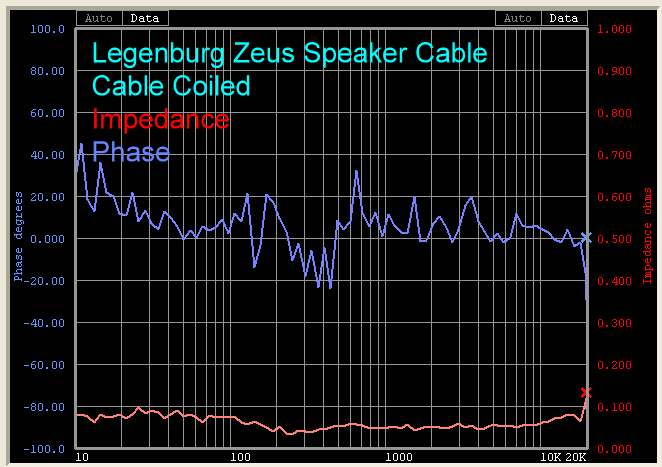Introduction
Over the past few years, several new companies that manufacture A/V cables
have emerged. Most of them sell these
cables at entry-level prices. The cables are good, basic designs.
Legenburg, although a new cable company, is
definitely not in the entry-level arena. It is high-end.
Does that mean the cables are really fancy?
Yup. Expensive? Yup.
Will the fancy, expensive cable critics laugh?
Probably. They always do.
Zeus
We reviewed the
Legenburg Artemis cables some months ago. The Zeus differ from the
Artemis in that the conductors are pure silver - called mono-crystal
rectangular pure silver (RCRPS). The connectors are rhodium-plated
mono-crystal copper.
Like the Artemis, the conductors are thin
ribbons and are in several sizes, each one insulated with foamed Teflon®
dielectric. Braided shielding is silver-plated.
The conductor design and layout is patented.
In Use
The review set consisted of two five-foot
pairs of XLR interconnects and one ten-foot pair of speaker cables with
spade lug terminations. Associated equipment included a McIntosh MCD201 SACD
player, Lamm L2 Reference preamplifier, Lamm M2.2 monoblock power
amplifiers, and Carver Amazing Mark IV ribbon speakers.
I used the cables for lots and lots of music
listening over the past weeks, and the first thing I have to mention is the
astounding build quality. Even the interconnects are like the proverbial
garden hose in size and stiffness. This can cause a problem if the area
behind your player and preamplifier is small.
Fortunately, I have plenty of
space, so I could utilize a wide bend radius. And this is a case where you
want the speaker cables to be the shortest length possible so they can go
direct from the amplifier binding posts to the speaker binding posts. This
way, you don't end up with cable that has to be coiled (although the bench
tests indicated that coiling the speaker cable did not cause any increased
inductance). Lastly, spade lugs for the speaker cables are really the choice
here, rather than banana plugs, since the cables are so stiff and heavy.
I did not hear any differences in the treble,
between the Artemis and the Zeus, but the bass did seem somewhat tighter. As
the bench test section will show, the resistance of the speaker cables is
very, very low (silver is a better conductor than copper), and this may have
improved the high current demand handling. Difficult to say really. But, I
was impressed enough that I am considering the Zeus as my new reference
cable in the lab. They just seem to be made to the same high standards as
the rest of the equipment in the lab, and that is important to me. I now
think that speaker cables should have a metal braid shielding, as they can
act like radio antennae just like interconnects. Although the RF in the
speaker cable would be small compared to the speaker voltage at high volume,
it would be comparable to the RF level vs. voltage in the interconnects at
lower volume. And, RF is not good to have in the A/V signal path. It can
interact with frequencies in the audible band and cause distortion. A small
amount of distortion? I think so, but why not remove it if you can?
On the Bench
I used a three-foot RCA interconnect
($1,280/pair) for the interconnect bench tests
because I can't measure the impedance on three conductors in an XLR
cable (it has to be two conductors).
I measured 30.5 pico-Farads/foot capacitance
and 0.27 micro-Henries/foot inductance for the interconnect (3 feet length).
The impedance for the interconnect stayed below 0.1 ohm all the way through the audible band,
except at about 18 kHz and above, where it maxed out at 0.15 ohm. The electrical phase
stayed within +600 (inductive) except at 220 Hz to 500 Hz, where
it went to about -200 (capacitive). This is superb performance.

For the speaker cable (10 feet length), I
measured 49.7 pico-Farads/foot capacitance and 0.17 micro-Henries/foot
inductance.
The phase for the speaker cable varied between
+400 and -600 when not coiled, and +400 to
-200 when coiled. The impedance stayed below 0.1 ohm pretty much
all the way through the audible band. The changes in the coiled
configuration indicate the movement towards more inductive behavior. The
impedance at 10 Hz can be taken as the DC resistance, which is 0.1 ohm or
less for both cables tested.


All impedance parameters - inductance,
capacitance, and resistance - are affected by each other. When I coiled the
speaker cable, the graph went more capacitive at some frequencies and more
inductive at others, and the impedance decreased slightly in the low
frequencies while increasing slightly in the upper frequencies. The fact
that the phase hovers around 00 does not mean there is no
inductance or capacitance; rather it just means the effects of inductance
and capacitance are balancing each other out. Legenburg has optimized their designs according to what they
think is the best outcome.
Conclusions
The Legenburg Zeus cables are truly an
astounding product. I was surprised to find them improving on the Artemis,
but they did, just a little, and noticeably. They are very expensive, but
having pure silver - and lots of it - in the conductors, makes them a
surprising value.
- John E. Johnson, Jr. -